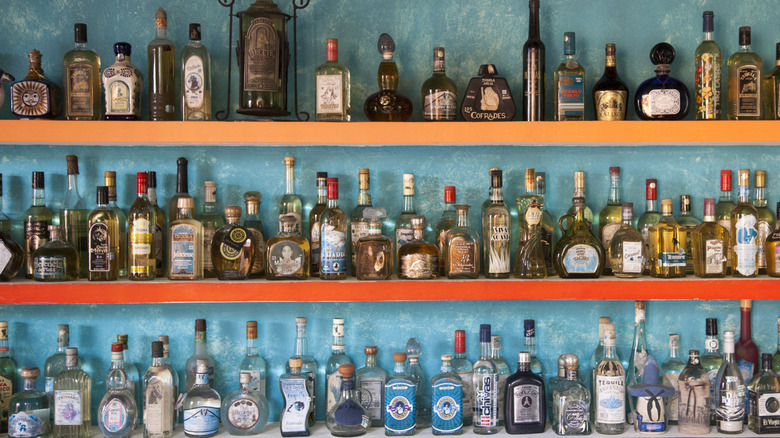The 4-Digit Number You Should Look For When Buying Your Next Bottle Of Tequila
Head to a liquor store for some tequila, and the selection can feel intimidating. As the fastest-growing spirit style in the United States (per the Distilled Spirits Council), more and more bottles appear on shelves, making differentiation tricky. Complicated by regulations regarding tequila's sugar standards and additives, it can be hard to know what's really in each bottle.
Thankfully, there's a four-digit number on every bottle of tequila that functions like a behind-the-scenes look into the producer. Called the NOM — short for Norma Oficial Mexicana — this code is assigned by the Mexican government as part of their official regulation.
Keep in mind that tequila can only be legally produced in five Mexican states, and must be made from blue weber agave specifically, among other requirements. The NOM reinforces that the bottle has been inspected for such standards, acting as an official stamp that the product is, in fact, real tequila. Furthermore, the four-digit code traces to the producer, lending you insight into the spirit's creation. Although there are now several thousand tequila brands, there are only around 140 certified distilleries, looking up a NOM to reveal all the brands made by one producer can reveal some intriguing overlap. So, some swift web searches will help nail down insightful qualities regarding the bottle.
The NOM number on a tequila bottle reveals its production facility
To make the best use of your tequila's NOM, you'll want to locate the number online. Especially with the best-selling tequila brands, even just a cursory Google search can reveal lots of information. You can find the NOM for many of the biggest production facilities and look for other bottles made by a beloved producer. But keep in mind that two tequilas having the same NOM doesn't mean their palates are identical. The source ingredients — as well as aging and additives — differ, although you can certainly expect some commonalities.
You can get even more insight by plugging the number into a dedicated site like Tequila Matchmaker. Created specifically for agave spirit transparency, this database reveals a wealth of details regarding the production steps, barrel options, and even the water source for every NOM. Furthermore, this search is the quickest way to check if a tequila is 100% agave. So, if you prefer your agave spirit tahona-extracted or distilled using a copper pot, using the NOM will help draw connections. And with tequila transmitting its terroir, the NOM brings consumers even more insight regarding the spirit's origins.
At times, consumers have used the NOM code to find distilleries that produce a single brand of tequila, looking for family-owned or "artisanal" products, assuming they'll be higher quality. However, large, multi-brand tequila production doesn't necessarily lead to a lower quality spirit. And, a NOM with a short brand list isn't a guarantee that a tequila wasn't mass produced. Tequila Matchmaker co-founder Grover Sanschagrin told Elle UK that brands — seeking to capitalize on the the draw artisanal labels have for some consumers — register bespoke NOMs while contracting production to large distilleries that produce in bulk. Instead, the NOM can verify how your tequila was produced and help you identify meticulously crafted gems created by producers that appeal to you.

